+86 311 85258258
+86 311 85258258
Feb. 04, 2021
Metal Casting
Metal casting is defined as the process of pouring molten metal into a mold that contains an intermediate cavity with the desired geometry and cooling it to form a solidified part. The term "casting" is also used to describe parts made by a casting process dating back to 6,000 years. Historically, it has been used to manufacture complex and/or large parts that are difficult or expensive to manufacture using other manufacturing processes.
Although almost all metals can be used, the most common are iron, steel, aluminum, magnesium, and copper-based alloys, such as bronze.
Zinc, aluminum, magnesium, and brass are widely used in die casting, while aluminum alloys, brass alloys, cast iron, and cast steel are very popular sand casting materials.

Metal casting can produce complex shapes
Features such as a cavity or hollow part can be easily achieved
Large parts can be manufactured in one piece
Can be cast using materials that are difficult to manufacture or expensive in other manufacturing processes
Compared with other manufacturing processes, medium and large casting is cheap
Almost all metals can be cast
Near-net shape, usually with little or no post-processing
For the above reasons, metal casting is one of the important mesh manufacturing techniques. Others include mesh forging, sheet metal stamping, additive manufacturing, and metal injection molding.
Relatively rough surface finish therefore must allow greater tolerances and is not suitable for mating interfaces
Metal casting (such as shell forming) has limitations in terms of size and style
Although additive manufacturing processes, such as adhesive spraying, have recently been used to make molds, making patterns can be time-consuming and expensive
Due to the high die cost, it can be very expensive for small to medium quantities of die casting
Part size and material selection depend on the casting process chosen. For example, only non-ferrous metals can be used in permanent molds
Pattern Making - Using suitable materials (such as wood, metal plastic, or plaster) to make a copy of the part to be cast.
Mold making - Mould making is a multi-step process in which patterns and cores are used to make a mold. The type of mold and how it is manufactured will depend on the type of metal casting. For example, sand casting uses sand from a sandbox to make molds, while mold casting uses hardened tool steel molds.
The metal is melted and poured -- the liquid is then melted and poured into the cavity by gravity or high pressure. The casting is then solidified and removed from the mold. Again, casting removal will depend on the type of metal casting.
Post-treatment - In this final step, the cast metal object is removed from the mold and then reshaped. During the dispensing process, the object is removed from any molding material and rough edges are removed.
PREVIOUS: Ductile Iron